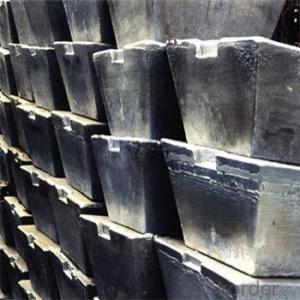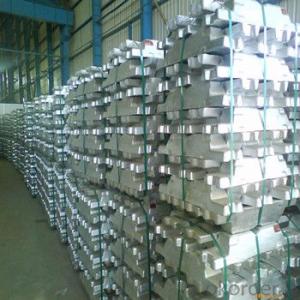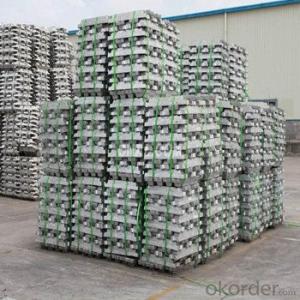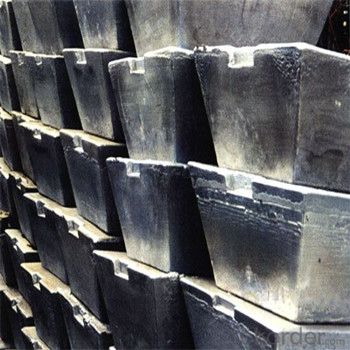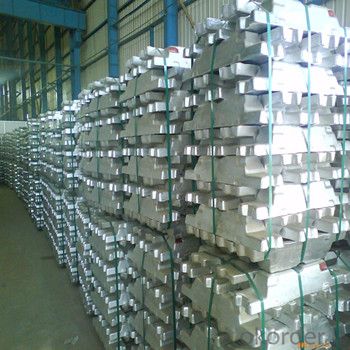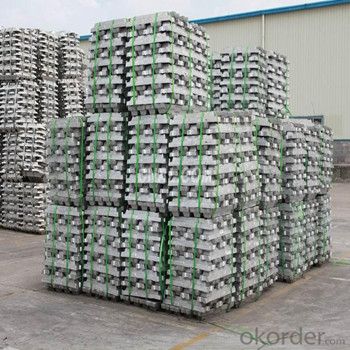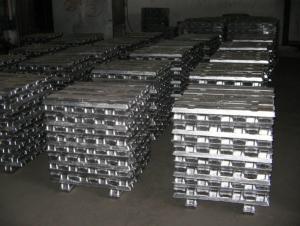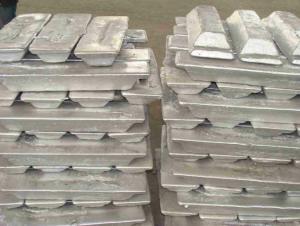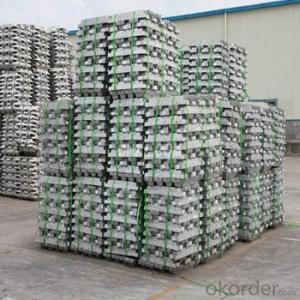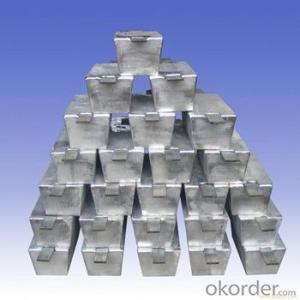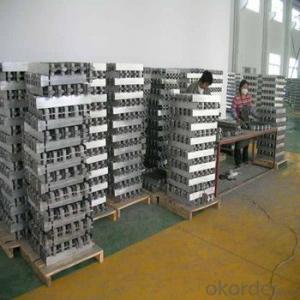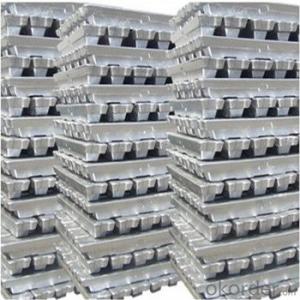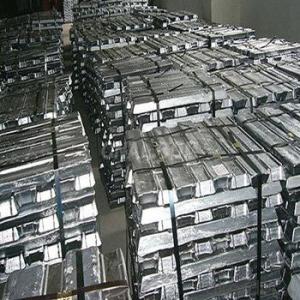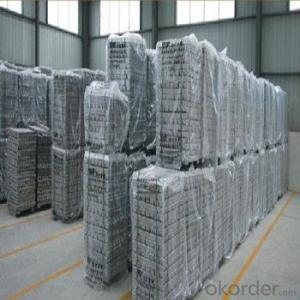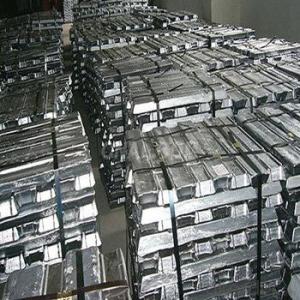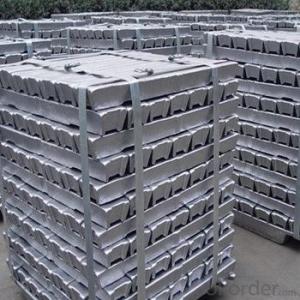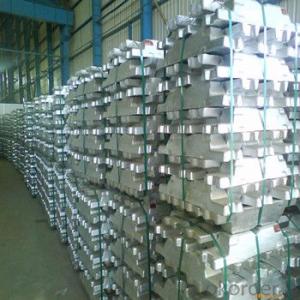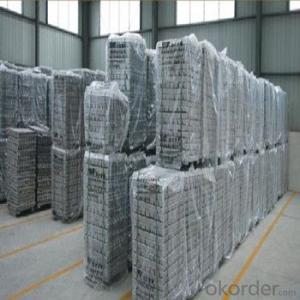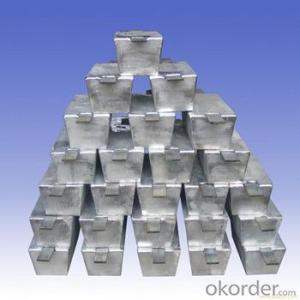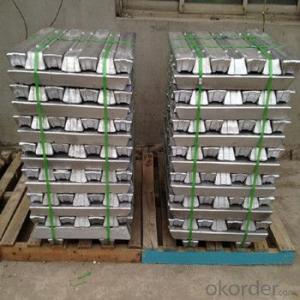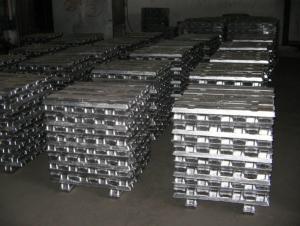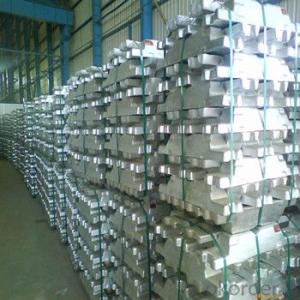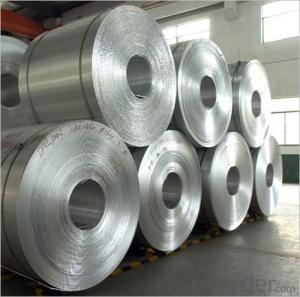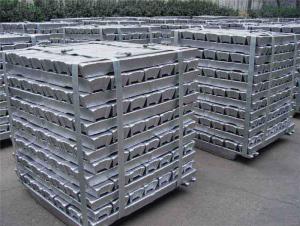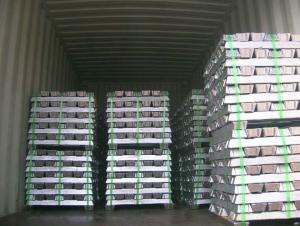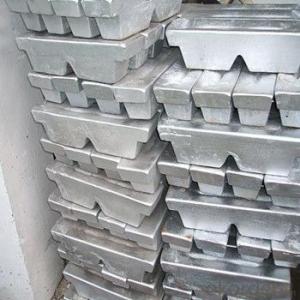Aluminum Ingot with Good Price and Good Quality
- Loading Port:
- China main port
- Payment Terms:
- TT OR LC
- Min Order Qty:
- 1000 m.t.
- Supply Capability:
- 10000 m.t./month
OKorder Service Pledge
OKorder Financial Service
You Might Also Like
Pure Aluminum Ingot Used for Industry
1.Structure of Aluminum Ingot Description
Aluminum Ingot is with the AL as the main chemical composition. Aluminum Ingot is used for industry,such as automobile,pinning and weaving,electron broadly and so on. Aluminum Ingot has the following advantages: easy control and operation, fast melting.
2.Main Features of the Aluminum Ingot
•High Purity
•Easy control and operation
•High strength
•Fast melting
•Competitive price
•Best Service
3. Aluminum Ingot Images
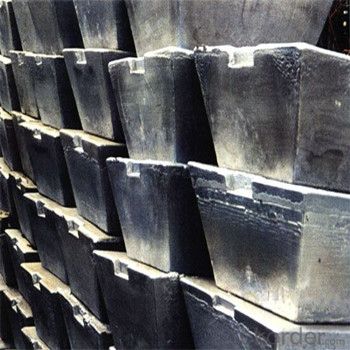
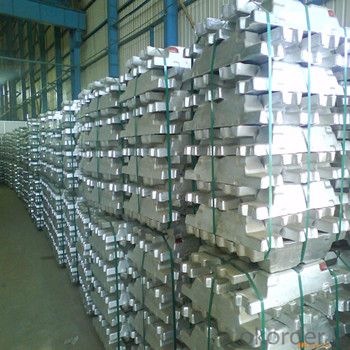
4. Aluminum Ingot Specification
Grade | Chemical Composition % | |||||||||
Al≥ | impurities ≤ | |||||||||
Si | Fe | Cu | Ga | Mg | Zn | Mn | others | Sum | ||
Al99.9 | 99.90 | 0.50 | 0.07 | 0.005 | 0.02 | 0.01 | 0.025 | - | 0.010 | 0.10 |
Al99.85 | 99.85 | 0.80 | 0.12 | 0.005 | 0.03 | 0.02 | 0.030 | - | 0.015 | 0.15 |
Al99.7 | 99.70 | 0.10 | 0.20 | 0.010 | 0.03 | 0.02 | 0.030 | - | 0.030 | 0.30 |
Al99.6 | 99.60 | 0.16 | 0.25 | 0.010 | 0.03 | 0.03 | 0.030 | - | 0.030 | 0.40 |
Al99.5 | 99.50 | 0.22 | 0.30 | 0.020 | 0.03 | 0.05 | 0.050 | - | 0.030 | 0.50 |
Al99.00 | 99.00 | 0.42 | 0.50 | 0.020 | 0.03 | 0.05 | 0.050 | - | 0.050 | 1.00 |
5.FAQ of Aluminum Ingot
We have organized several common questions for our clients,may help you sincerely:
①How about your company?
A world class manufacturer & supplier of castings forging in carbon steel and alloy steel,is one of the large-scale professional investment casting production bases in China,consisting of both casting foundry forging and machining factory. Annually more than 8000 tons Precision casting and forging parts are exported to markets in Europe,America and Japan. OEM casting and forging service available according to customer’s requirements.
②How to guarantee the quality of the products?
We have established the international advanced quality management system,every link from raw material to final product we have strict quality test;We resolutely put an end to unqualified products flowing into the market. At the same time, we will provide necessary follow-up service assurance.
③How long can we receive the product after purchase?
In the purchase of product within three working days, We will arrange the factory delivery as soon as possible. The pecific time of receiving is related to the state and position of customers.Commonly 7 to 10 working days can be served.
- Q: The difference between electrolytic aluminium, alumina and aluminium ingot
- You said, "the aluminum factory also needs bauxite," then the aluminum smelter is not necessarily a single electrolytic aluminum plant, there may be other production processes.
- Q: How much is the price of the common aluminum sheet on the basis of the aluminum ingot? How much is the price of the broken aluminum alloy profile on the basis of the aluminum ingot?
- According to different manufacturers and brands, processing costs are slightly different, the general profiles of the higher processing costs, quality and material aspects can be guaranteed, small factories processing fees lower.
- Q: How are aluminum ingots used in the production of furniture?
- Aluminum ingots find various applications in the production of furniture. Primarily, they serve as the main raw material for creating lightweight and long-lasting furniture frames. The ingots are melted and shaped into desired forms and sizes, forming the structure or skeleton of the furniture piece. Once the aluminum frame is formed, it undergoes further processing, such as cutting, bending, and welding, to achieve the desired design and functionality. This allows for the creation of intricate and contemporary furniture designs that are visually appealing and practical. In addition, aluminum ingots are commonly utilized in the production of outdoor furniture due to their excellent resistance to corrosion. Outdoor furniture faces harsh weather conditions, and the natural resistance of aluminum to rust and deterioration makes it an ideal choice for such applications. Furthermore, aluminum ingots can be employed to create different furniture components, including legs, armrests, and decorative elements. These components are then assembled with other materials, such as wood, glass, or fabric, to create the final furniture product. The use of aluminum ingots in furniture production offers various advantages. Aluminum is lightweight, making it easy to move and rearrange the furniture. It also provides exceptional strength and durability, ensuring the furniture's longevity. Moreover, aluminum is highly recyclable, making it an environmentally friendly choice for furniture manufacturing. In conclusion, aluminum ingots play a crucial role in furniture production. They are transformed into frames, components, and decorative elements, providing lightweight, durable, and stylish furniture options. The versatility and sustainability of aluminum make it a preferred choice for furniture manufacturers, particularly for outdoor and modern designs.
- Q: How are aluminum ingots used in the production of sports equipment?
- Aluminum ingots are widely used in the production of sports equipment due to their lightweight, durable, and corrosion-resistant properties. These ingots serve as the primary material for various sports equipment, including baseball bats, tennis rackets, golf clubs, and bicycles. In the manufacturing process, aluminum ingots are melted and then poured into molds to create the desired shape and size of the sports equipment. The molten aluminum is then cooled and solidified, resulting in a strong and solid structure. One of the main advantages of using aluminum ingots is their lightweight nature. This property makes the sports equipment easier to handle and maneuver, allowing athletes to exert less effort during play. For example, aluminum baseball bats are renowned for their lightweight construction, enabling players to swing the bat with greater speed and accuracy. Furthermore, aluminum ingots offer excellent durability, ensuring a longer lifespan for the sports equipment. They are known for their resistance to wear and tear, making them ideal for intense sports activities. For instance, aluminum tennis rackets can withstand the high impact of tennis balls and maintain their shape and performance over a prolonged period. Additionally, aluminum ingots possess exceptional corrosion resistance. This property is beneficial for sports equipment that is exposed to various environmental conditions, such as bicycles. Aluminum bicycle frames made from ingots are resistant to rust and corrosion, providing a longer lifespan and enhanced performance. In conclusion, aluminum ingots play a crucial role in the production of sports equipment. With their lightweight, durable, and corrosion-resistant properties, they contribute to the creation of high-quality and high-performance sports gear, enabling athletes to excel in their respective sports.
- Q: What are the challenges in recycling aluminum ingots?
- Recycling aluminum ingots presents several challenges that need to be addressed. To begin with, a major obstacle is the collection and sorting of aluminum waste. Unlike paper or plastic, aluminum waste is often mixed with other materials, making separation and sorting difficult. This necessitates the use of advanced sorting technologies and manual labor, which can be time-consuming and expensive. Additionally, the energy-intensive nature of aluminum production poses a challenge. Although recycling aluminum requires less energy than primary production, it still requires a significant amount of electricity. The process of melting down and purifying aluminum ingots requires high temperatures, which consume a considerable amount of energy. Furthermore, contamination is a persistent issue in recycling aluminum ingots. Even with advanced sorting technologies, it is difficult to guarantee that recycled aluminum is free from impurities. Contaminants like paint, coatings, or other metals can negatively impact the quality of the final product, making it less appealing to manufacturers. Moreover, transportation logistics present another challenge in the recycling process. Aluminum ingots are heavy and bulky, making their transportation from collection centers to recycling plants costly and challenging. This adds to the overall expenses of recycling. Lastly, the global market demand for recycled aluminum can fluctuate, making it challenging for recyclers to find buyers for their ingots. Economic factors, such as the price of primary aluminum and the demand for recycled materials in the market, can impact the profitability and feasibility of recycling aluminum ingots. Despite these challenges, recycling aluminum ingots remains a crucial practice due to its environmental benefits and the conservation of valuable resources. Continued research and innovation in recycling technologies can help overcome these challenges and make the process more efficient and cost-effective.
- Q: What is the role of aluminum ingots in the production of aircraft?
- Aluminum ingots play a crucial role in the production of aircraft as they are the primary raw material used in manufacturing various components, such as the fuselage, wings, and other structural parts. Due to its lightweight, high strength, and corrosion-resistant properties, aluminum is an ideal material for aircraft construction. The ingots are melted down and transformed into sheets, plates, and extrusions, which are then fabricated and assembled into the airframe. This versatile metal allows for weight reduction, increased fuel efficiency, and improved performance, making it an essential element in modern aircraft production.
- Q: What is the difference between aluminium ingot and aluminium alloy ingot? Is the broken aluminium standard sold on the market now?
- The so-called aluminum alloy usually refers to contain certain other chemical elements of aluminum, such as common aluminum silicon alloy, aluminum magnesium alloy. ADC-12 is Al Si alloy.
- Q: How are aluminum ingots used in the packaging industry?
- Aluminum ingots are used in the packaging industry to produce various forms of aluminum packaging materials, such as foils, cans, and containers. These ingots are melted and then rolled or extruded to create thin sheets or other desired shapes. The use of aluminum in packaging provides excellent barrier properties against moisture, light, and oxygen, ensuring the preservation and quality of the packaged products. Additionally, aluminum packaging is lightweight, durable, and recyclable, making it a popular choice in the industry.
- Q: I want to melt aluminum scrap into aluminium ingots. How can I make them?
- Non-standard aluminum ingots without any process requirements, simply put into the melting of aluminum, and then cast into ingots only. Mainly based on your investment, select a smelting equipment. If you want to produce label aluminum ingot, that needs to pay attention to a lot of problems. I'm a recycling plant. I have a production process for recycled aluminum in my room for your reference.
- Q: What does nonstandard pure aluminium ingot mean?
- Pure aluminium ingot: Aluminum exists in the surface, in addition to iron (Fe) in ranking the second metal elements, since the electrolysis method was invented, human made from bauxite surface, refining of high purity (more than 99.7%) of aluminum, is pure aluminum ingot.
Send your message to us
Aluminum Ingot with Good Price and Good Quality
- Loading Port:
- China main port
- Payment Terms:
- TT OR LC
- Min Order Qty:
- 1000 m.t.
- Supply Capability:
- 10000 m.t./month
OKorder Service Pledge
OKorder Financial Service
Similar products
Hot products
Hot Searches
